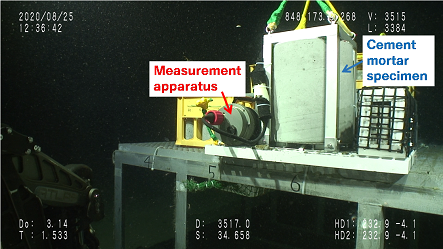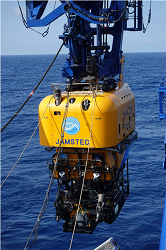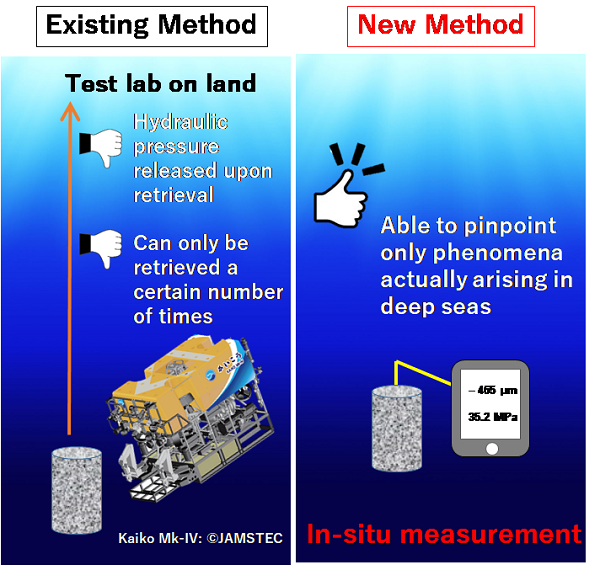Research Group Initiates First-Ever In-Situ Measurement of Mechanical Properties of Hardened Cement Mortar in Deep Sea
TopicsResearch Will Contribute to the Establishment of Design Methodologies for Deep-Sea Infrastructure
TOKYO, March 26, 2021 -- Ube Industries, Ltd., the Port and Airport Research Institute, Japan Agency for Marine-Earth Science and Technology (JAMSTEC), Tokyo Institute of Technology, and Tokyo University of Marine Science and Technology today announced that a joint research group has established a method for evaluating the mechanical properties of hardened cement mortar and initiated the first-ever in-situ data measurement. The research project aims to contribute to the construction of deep-sea infrastructure. By collecting data on the hydraulic pressure arising inside of hardened cement mortar at a site on the deep-sea floor, the research is expected to yield useful data for the future development of infrastructure materials for deep-sea applications and the establishment of design methodologies for deep-sea structures.
The research is reported in a paper published in the Journal of Advanced Concrete Technology, Volume 19, which was released online on March 26, 2021.
Download the paper:https://www.jstage.jst.go.jp/article/jact/19/3/19_226/_pdf/-char/en

Left: Measurement apparatus next to cement mortar specimen at a water depth of approximately 3,500 meters
(Copyrighted image courtesy of JAMSTEC)

Right: Remotely operated vehicle ROV Kaiko Mk-IV, used to install the cement mortar specimen
Research Details
The purpose of the research is to elucidate the mechanical propertiesof hardened cement mortar due to the effects of high hydraulic pressure over both a short and long period of time. Conventionally, a submersible is used to recover the cement mortar specimens deployed on the deep-sea floor, and the changes in the mortar specimen are measured after retrieval However, this method leaves open the possibility that pressure change from deep sea to sea surface on retrieval causes the changes in the cement mortar specimen, potentially preventing an accurate understanding of phenomena arising in the deep sea. Furthermore, testing that utilizes a water tank to simulate the high hydraulic pressure in the deep sea cannot reproduce the phenomena to the degree that they would arise in an actual structure, or the effects of actual currents and attachment of marine organisms.
The researchers established a method that enables continuous in-situ measurement of water pressure and strain arising in a cement mortar specimen on the deep-sea floor. The researchers can then pinpoint only the phenomena actually arising in the deep sea, thereby ensuring accurate data for analysis and interpretation.
In July 2020, the research group deployed a cement mortar specimen and measurement apparatus at a water depth of approximately 3,500 meters in the northeastern rim of the Nankai Trough, located about 70 kilometers from the tip of the Izu Peninsula. The specimen will be recovered in fiscal 2021 and researchers will analyze the data.
Research Background
Japan is the sixth largest maritime nation measured by the area of its economic exclusive zone (EEZ) and territorial waters. Consequently, active ocean utilization is one of the important issues facing Japan. Within Japan's EEZ, deep seas1 account for a very high proportion of the ocean territory, and in recent years various possibilities for the development of ocean resources has been studied. Other possibilities also are being discussed, which have the potential to create new fields of science and industry. These include ocean energy utilization such as tidal power generation, installation of data centers to take advantage of the sea floor, construction of large neutrino detectors, and deep-sea city concepts.
Utilization of cement, which offers many design possibilities and is highly versatile, is being studied for future construction of ocean infrastructure in deep seas. Cement is manufactured using limestone, which can be entirely sourced in Japan, a country where underground resources are otherwise typically scarce, so it promises the advantage of stable supply as a material.

However, there has been scarcely any evaluation of the impacts of the extreme deep-sea environment on structures that utilize cement. In recent research, the researchers found that hardened cement mortar deteriorates significantly in deep seas2, making it clear that deep-sea infrastructure cannot be constructed using existing knowledge and design methodologies alone. It is becoming important to collect basic data as a step toward constructing deep-sea infrastructure.
1Deep-sea marine environments are defined as those with a water depth greater than 200 meters. Deep seas are characterized by high hydraulic pressures and low water temperatures. The in-situ measurements discussed in this research are being conducted at a depth of approximately 3,500 meters, where the water pressure is around 350 times greater than atmospheric pressure at sea level.
Members of Joint Research Group
Ube Industries:
Keisuke Takahashi, Chief Researcher, Technical Development Center
Mari Kobayashi, Researcher, Technical Development Center
Port and Airport Research Institute:
Takafumi Kasaya, Group Leader, Research Institute for Marine Resources Utilization Submarine Resources Research Center
JAMSTEC:
Takafumi Kasaya, Group Leader, Research Institute for Marine Resources Utilization Submarine Resources Research Center
Shun Nomura, Technical Researcher, Department of Mathematical Science and Advanced Technology
Tokyo Institute of Technology:
Mitsuyasu Iwanami, Professor, Department of Civil and Environmental Engineering
Tokyo University of Marine Science and Technology:
Toshiro Yamanaka, Professor, Department of Ocean and Environmental Sciences
Makita Hiroko, Associate Professor, Department of Ocean and Environmental Sciences
Shinpei Gotoh, Assistant Professor, Department of Marine Electronics and Mechanical Engineering
For inquiries, please contact:
Ube Industries, Ltd.
General Affairs & Public Relations Group
Address: Seavans North Building, 1-2-1 Shibaura, Minato-ku, Tokyo 105-8449
Phone : +81 (3) 5419-6110
Port and Airport Research Institute
National Institute of Maritime, Port and Aviation Technology
Planning, Coordination and Disaster Prevention Division
Address: 3-1-1, Nagase, Yokosuka, Kanagawa 239-0826
Phone: +81 (46) 844-5040
Japan Agency for Marine-Earth Science and Technology (JAMSTEC)
Public Relations Section, Marine Science and Technology Strategy Department
Address: 3173-25 Showa-machi, Kanazawa-ku, Yokohama, Kanagawa 236-0001
Phone: +81 (45) 778-5690
Tokyo Institute of Technology
Public Relations Group
Address: 2-12-1 Ookayama, Meguro-ku, Tokyo 152-8550
Phone: +81 (3) 5734-2975
Email: media@jim.titech.ac.jp
Tokyo University of Marine Science and Technology
Public Relations Section, General Affairs Division
Address: 4-5-7 Konan, Minato-ku, Tokyo 108-847
Phone: +81 (3) 5463-0355



